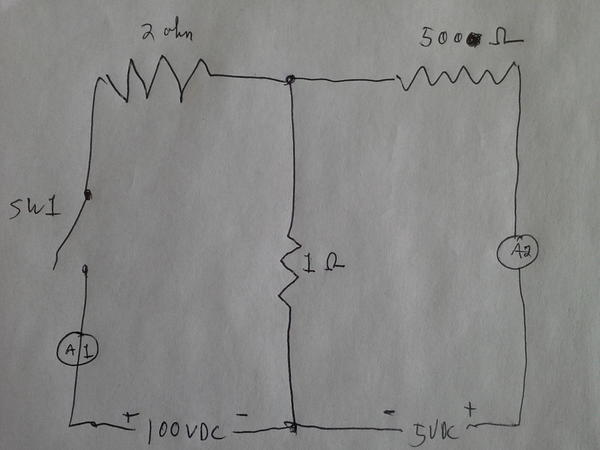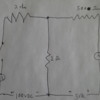Replies sorted oldest to newest
Build the circuit HERE and see what happens.
Couple ways to do it, Kirchoff's voltage law is one. Sum of the voltage drops around each loop must be zero. Calculate the voltage across each resistance using E=IR
Using your A1 and A2 notation, assuming + to - voltage drops
Left loop-
100V = 2A1 + 1 x (A1 + A2) because both A1 and A2 flow in the 1 ohm resistor
Right loop
5V = 500A2 + 1 x (A1 + A2) ditto
Combining and re-arranging terms we get-
100V = 3A1 + 1A2
5V = 1A1 + 501A2
Solving simultaneously, we get
85 = -1502A2 (negative sign means that the current is flowing against the voltage source)
A2 = -.0566 amperes
so
100V = 3A1 - .0566 amperes
100.0566 = 3A1
A1 = 33.352 amperes
A2 = -.0566 amperes
Current in 1 ohm resistor = 33.296 amperes
So, in words the 100 volt circuit forces .0566 amps backwards through the 5V battery!
The way it is calculated is to write two loop equations in the two unknown currents, a and b. Then solve the two simultaneous equations for a and b.
Oops, didn't answer your question. Voltage across 500 ohm resistor will be E = 500A2, or 28.296 volts. Left side will be positive.
Thanks for the input. Now I have to try to digest it. I hadn't anticipated a reverse flow through the right hand power supply
Suppose instead of 5 volts the right power supply was also 100VDC, and the right load was 10,000 ohms. Then what would be the effect on the right hand circuit of closing S1?
RJR posted:Thanks for the input. Now I have to try to digest it. I hadn't anticipated a reverse flow through the right hand power supply
Suppose instead of 5 volts the right power supply was also 100VDC, and the right load was 10,000 ohms. Then what would be the effect on the right hand circuit of closing S1?
Just plug the new values into Prof's excellent solution.
This will take me awhile. It's been a very long time since I played with this formula building stuff.
In the formula, are A1 and A2 amperage in the particular circuits?
Prof, ref your second sentence: Would not the sum of the voltage drops around a loop have to equal the applied voltage? I'm looking at Kirschoff's Law in wikipedia, where I see: "The directed sum of the electrical potential differences (voltage) around any closed network is zero, or: More simply, the sum of the emfs in any closed loop is equivalent to the sum of the potential drops in that loop, or: The algebraic sum of the products of the resistances of the conductors and the currents in them in a closed loop is equal to the total emf available in that loop." I don't know what "directed sum" means, but the second sentence seems to say the sum must be the total voltage impressed on the loop.
It's been 50+ years since I last was involved with formulas like  and my grandkids haven't yet asked for help on such, so I'm lost.
and my grandkids haven't yet asked for help on such, so I'm lost.
You can do the math, but from experience, you can "fake it" in this case. I say that because the 10,000 ohms on the right side is so high compared to the resistances on the left.
Ignoring the right side, the left side totals 3 ohms, giving a current of 33.333 amps. This gives 33.333 volts across the one ohm resistor, the top of the resistor being the positive end.
Now looking at the right side, the 33.333 volts across the 1 ohm resistor is in series with the 100 VDC source on the right, but is opposite in polarity, so the voltages subtract, giving 66.667 volts across the resistor. Because the 100 VDC source is higher than the 33.333 volts across the resistor, the 100 VDC source "wins," polarity-wise. That makes the right side of the 10,000 ohm resistor 66.667 volts positive with respect to the left side. This gives a current of .0066667 amperes flowing "forward" in the right side.
I was able to fake it because I saw that the current through the right side was so much less than the current through the left it would have almost no effect on the current in the common 1 ohm resistor. Kind of like having a mouse help an elephant pull a load. If you work through the math you will see that may "fake" calculation is accurate to about .01 percent.
To your question on sums, think of it this way, whatever voltage the source supplies must be "used up" by the rest of the circuit. So the source provides 100 and the resistors use up 100, leaving none left over for a balance (sum) of zero. The trick is to keep the polarities straight!
Plcprof, I do appreciate your taking the time to lead me through this.
Let me tell you what is behind my initial query. I run DCS on my layout. DCS send a signal, a packet which of course is composed of electrons, through the feed wires to the track. I'm wondering the extent to which also sending high amperage train power through an undersized feed, which results in voltage loss, could diminish the strength of that signal. The example I posed may or may not be truly illustrative of this issue.
Thanks again, RJR
RJR posted:The example I posed may or may not be truly illustrative of this issue.
Your example is generally called "DC-circuit analysis" when you take college Electronics 101. A subsequent topic is "AC-circuit analysis" where the frequency of the signals is relevant. Your high-current track voltage is at 60 Hz. The DCS signal is in the MHz region. How these two AC signals interact is somewhat tricky to analyze with parameters such as capacitance in the cables, inductance in the wiring and tracks, etc. Hence the recommendations for star-wiring, home-run wiring, etc.
Additionally, the interaction changes over time. For example, all engine electronics has a bridge-rectifier to convert the AC to DC. So at each zero-crossing of the AC-voltage, there's a region of about a Volt or so where no current flows. Then, as the voltage rises and the diodes in the bridge turn on, current all of sudden starts flowing and the voltage vs. current relationship takes a wild jump. This is why you hear anecdotal evidence that DCS signaling works better on DC track voltage since you don't have bridge rectifiers turning on/off 120 times per second upsetting the apple cart.
One approach to dealing with big-signal small-signal interaction is to separate their frequencies as widely as practical. The magic is that the electrical resistance (technically the impedance) of a 1 cent capacitor or inductor is exactly proportional to frequency. Increase frequency 10 times and the impedance changes by a factor of 10. This makes it easy to separate/isolate the "large" 60 Hz power signal from the "small" MHz DCS signal. Perhaps an oversimplification but since 60 Hz track voltage and the DCS signal are separated by a frequency ratio of well over 1,000 times, a single capacitor (or inductor) can knock down the "large" 60 Hz power signal by over 1000 times to where it is inconsequentially small compared to the DCS signal.






